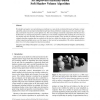Free Online Productivity Tools
i2Speak
i2Symbol
i2OCR
iTex2Img
iWeb2Print
iWeb2Shot
i2Type
iPdf2Split
iPdf2Merge
i2Bopomofo
i2Arabic
i2Style
i2Image
i2PDF
iLatex2Rtf
Sci2ools
106
click to vote
CGF
2006
2006
An Improved Physically-Based Soft Shadow Volume Algorithm
We identify and analyze several performance problems in a state-of-the-art physically-based soft shadow volume algorithm, and present an improved method that alleviates these problems by replacing an overly conservative spatial acceleration structure by a more efficient one. The new technique consistently outperforms both the previous method and a ray tracing-based reference solution in several realistic situations while retaining the correctness of the solution and other desirable characteristics of the previous method. These include the unintrusiveness of the original algorithm, meaning that our method can be used as a black-box shadow solver in any offline renderer without requiring multiple passes over the image or other special accommodation. We achieve speedup factors
CGF 2006 | Conservative Spatial Acceleration | Physically-based Soft Shadow | Ray Tracing-based Reference |
Related Content
| Added | 11 Dec 2010 |
| Updated | 11 Dec 2010 |
| Type | Journal |
| Year | 2006 |
| Where | CGF |
| Authors | Jaakko Lehtinen, Samuli Laine, Timo Aila |
Comments (0)

